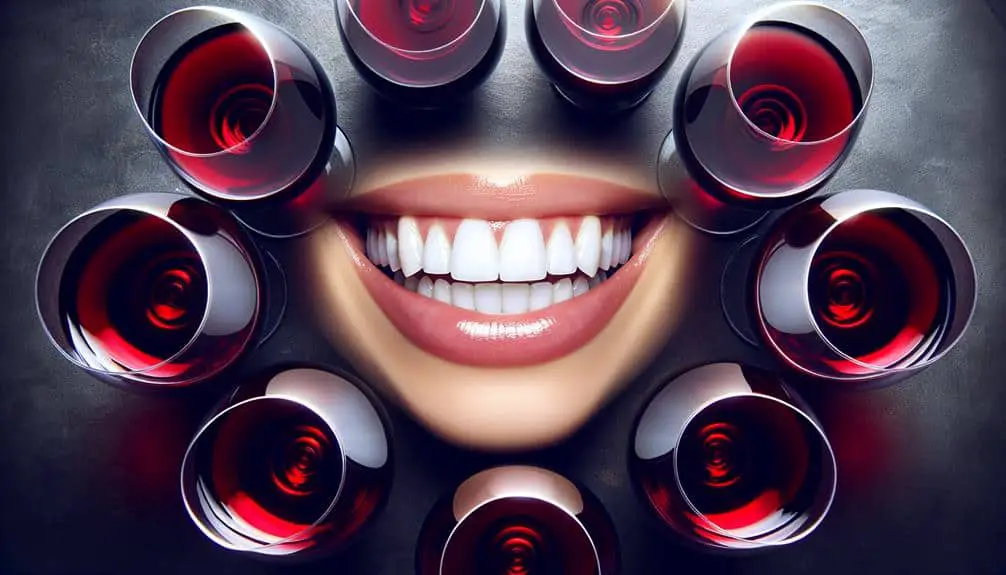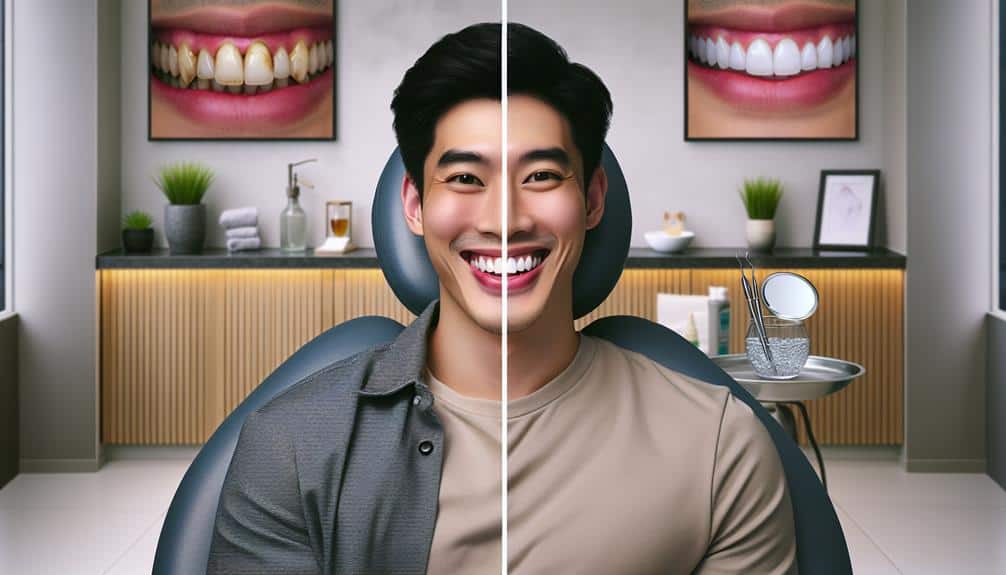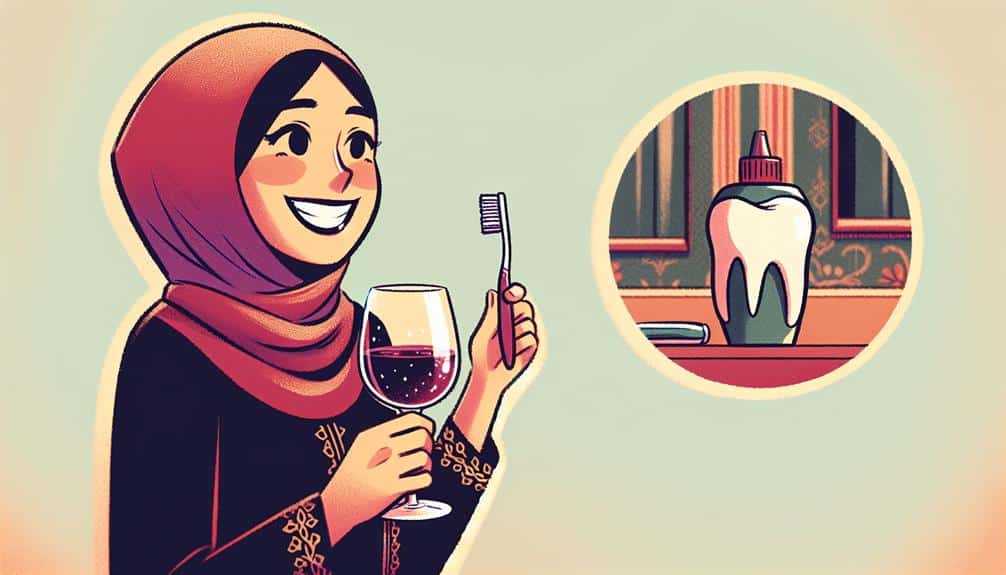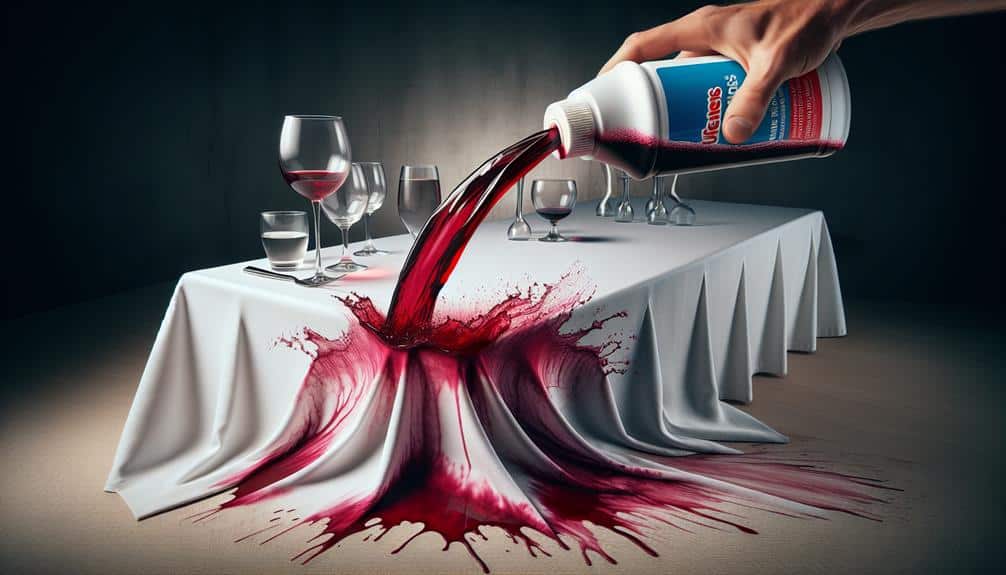For wine stains on teeth, consider professional whitening treatments. Custom trays guarantee even bleach gel application to effectively remove stains. Over-the-counter products like whitening strips can also help at home. Whitening toothpaste and mouthwash can tackle surface stains, but for stubborn ones, veneers may be best. In-office whitening offers fast, long-lasting results using advanced tech. Natural remedies like oil pulling with coconut oil or baking soda paste can help too. Keep exploring cosmetic dentistry options for a bright, stain-free smile. More information on various treatments awaits to enhance your smile's radiance.
Key Points
- Professional whitening treatments with custom trays for effective stain removal.
- Over-the-counter whitening products with bleaching agents for at-home use.
- Whitening toothpaste and mouthwash to polish away surface wine stains.
- In-office whitening procedures by dental professionals for fast and lasting results.
- Natural remedies like baking soda paste and oil pulling for cost-effective stain removal.
Professional Whitening Treatments
If you're seeking to effectively eliminate wine stains from your teeth, professional whitening treatments offer a dependable solution. Custom trays are commonly utilized in professional whitening procedures to guarantee that the bleaching gel is applied evenly to all your teeth. These trays are tailored specifically for your mouth, providing a comfortable fit that allows the bleaching gel to work effectively.
During a professional whitening treatment, the dentist will apply a strong bleaching gel to your teeth. This bleaching gel typically contains a higher concentration of whitening agents compared to over-the-counter products, ensuring more effective stain removal. The custom trays help in keeping the gel in place, maximizing its contact with the stained areas.
The bleaching gel used in professional treatments is designed to break down the wine stains on your teeth, revealing a brighter and whiter smile. The custom trays and precise application of the gel ensure that all areas of your teeth receive the whitening treatment evenly, resulting in a uniform and attractive outcome.
Over-the-Counter Whitening Products
Over-the-counter whitening products provide convenient and accessible options for addressing wine stains on your teeth. These products typically contain bleaching agents like hydrogen peroxide or carbamide peroxide, which help break down and remove stains effectively. When using over-the-counter whitening products, it's essential to follow the instructions carefully to achieve the best results.
DIY remedies such as whitening strips or whitening trays can be effective in treating wine stains at home. Whitening strips are thin, flexible strips coated with a peroxide-based gel that conform to the shape of your teeth. Whitening trays are custom-fitted trays that you fill with a whitening solution and wear over your teeth.
To prevent future wine stains, consider incorporating preventive measures such as drinking water between glasses of wine, brushing your teeth after consuming wine, and using a straw to minimize contact between the wine and your teeth. With consistent use of over-the-counter whitening products and preventive measures, you can maintain a bright, stain-free smile.
Whitening Toothpaste and Mouthwash
When looking to address wine stains on your teeth, consider incorporating whitening toothpaste and mouthwash into your daily oral care routine for a brighter smile. Whitening toothpaste typically contains abrasive particles or chemicals that help remove surface stains caused by foods like wine. These toothpaste options are formulated to be gentle on your enamel while effectively polishing away discoloration.
Mouthwashes designed for whitening purposes often contain hydrogen peroxide or other whitening agents to help lighten stains on the teeth. Using a whitening mouthwash after brushing can provide an extra layer of stain-fighting power.
While whitening toothpaste and mouthwash can help improve the appearance of your teeth, they may not be as effective for deeper or more stubborn stains. In such cases, cosmetic dentistry options like dental veneers or bonding could be considered for a more permanent solution.
In-Office Whitening Procedures
Consider taking your teeth whitening to the next level with professional in-office whitening procedures for a more thorough and effective solution to combat wine stains. In-office whitening procedures offer fast results, making them ideal for individuals seeking immediate improvements in their smile appearance. These procedures are performed by experienced dental professionals who utilize advanced whitening agents and technologies to achieve noticeable whitening effects in a short amount of time.
One of the key advantages of in-office whitening is its long-lasting effects. Unlike over-the-counter products, in-office treatments provide deep and thorough whitening that can keep your smile bright for an extended period. The professional-grade whitening agents used in these procedures penetrate the teeth more effectively, resulting in a more extensive and durable whitening outcome.
Natural Remedies for Stains
For individuals looking to address wine stains on their teeth, exploring natural remedies can be a beneficial and cost-effective option to explore. When it comes to tackling these stains, DIY solutions and herbal remedies can be effective alternatives to professional treatments. Home remedies offer a more natural approach, using ingredients commonly found in your kitchen.
One popular DIY technique is to create a paste using baking soda and hydrogen peroxide. The abrasiveness of baking soda helps scrub away surface stains, while hydrogen peroxide acts as a bleaching agent. Another option is oil pulling with coconut oil, known for its antimicrobial properties. Swishing coconut oil in your mouth for about 15-20 minutes can help lift stains and promote oral health.
Herbal remedies like sage and mint leaves can also aid in reducing discoloration. Chewing on these leaves can freshen breath and potentially diminish the appearance of wine stains over time. When considering natural remedies for wine stains, consistency and patience are key to achieving noticeable results without the expense of professional treatments.
Frequently Asked Questions
Are There Any Specific Foods or Drinks That Should Be Avoided to Prevent Future Wine Stains on Teeth?
To prevent future wine stains on your teeth, avoid red wine and other pigmented beverages. Maintain good oral hygiene by brushing and flossing regularly. Limit consumption of staining foods and drinks, and consider using a straw when enjoying them.
How Long Do the Results of Professional Whitening Treatments Typically Last?
Like a well-crafted painting, the longevity of professional whitening treatments can vary. Typically, results last 1-3 years with proper maintenance. Routine touch-up treatments, along with avoiding staining foods and drinks, help maintain a vibrant smile.
Can Cosmetic Dentistry Options for Wine Stains Also Improve Overall Oral Health?
Improving oral health through cosmetic dentistry options for wine stains can benefit you in various ways. These procedures not only enhance your smile but also promote good oral hygiene practices, leading to long-term positive effects on your overall oral health.
Are There Any Potential Side Effects or Risks Associated With In-Office Whitening Procedures?
When opting for in-office whitening, be mindful of potential risks like tooth sensitivity or gum irritation. While effectiveness comparisons vary, consult your dentist to weigh the benefits against any side effects to make an informed decision.
Do Insurance Plans Typically Cover the Cost of Cosmetic Dentistry Options for Wine Stains?
Insurance coverage for cosmetic dentistry options for wine stains varies. Some plans may provide partial coverage, but limitations often apply. Alternative treatments like teeth whitening may be more cost-effective. Consult with your dentist and insurance provider for specific details.



